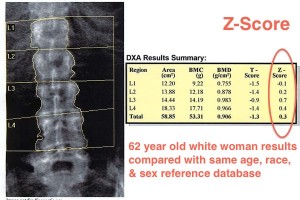
Z-score is a standardized number that you may see on your bone density scan results or reports. Your bone mineral density (BMD) at each skeletal site of measurement is compared to a reference database of same age, race/ethnicity, and sex. The use of this calculated score depends on your age and menopausal status.
Z-score Used for Diagnosis
For children, premenopausal women, and men under the age of 50, the Z-score is used for diagnosis. Using the criteria defined by the International Society for Clinical Densitometry:
- If the Z-score is -2.0 or lower, the result is “below the expected range for age.”
- If the Z score is above -2.0, the result is defined as “within the expected range for age.”
Z-score Results in Postmenopausal Women and Men
For postmenopausal women and men age 50 and older, another standardized number called the T-score is used for diagnosis. A low Z-score in this group may indicate other factors could be contributing to low bone density results. A further evaluation to look for underlying causes for low bone density may be beneficial to identify hidden problems such as vitamin D deficiency, celiac disease, excessive calcium loss in the urine, or high parathyroid hormone. However, no specific level of Z-score has been identified to correlate with findings of underlying problems or so-called “secondary causes.”
Other Resources:
Official Positions of the International Society for Clinical Densitometry
http://www.iscd.org/Visitors/pdfs/ISCD2007OfficialPositions-Combined-AdultandPediatric.pdf
